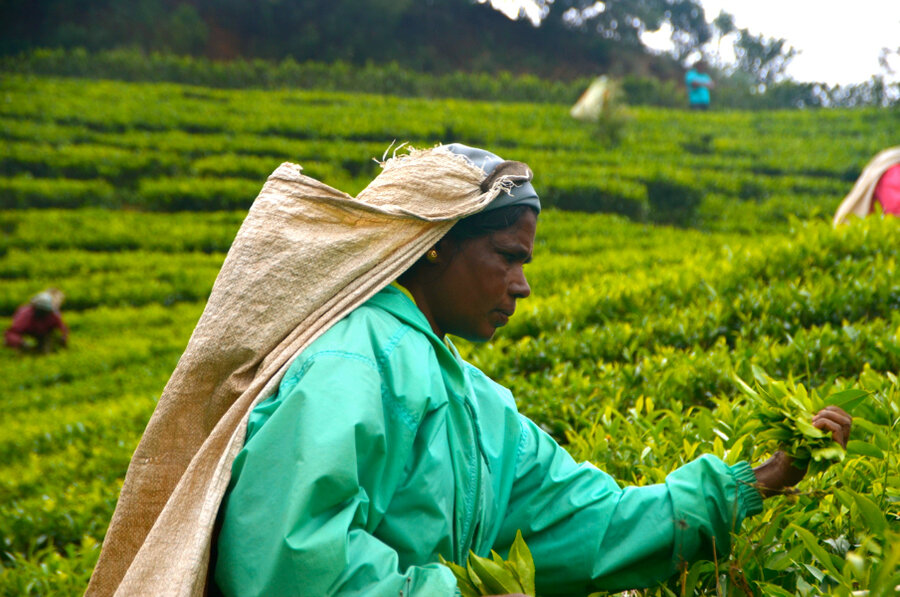Sri Lanka tea plantations go greener
Loading...
| Nuwara Eliya, Sri Lanka
Tea-grower D.M. Sudumenink is nearly 70 years old and has won prizes for her crop. All the same, the retired schoolteacher is keen to know more about how she can improve her tea-growing and keep her cropland clean.
With 300 other farmers working the hills around Indigahadoowa in the tea-growing mountains in the southern, central part of the island, Ms. Sudumenink is getting training on, among other things, how to work using less chemical fertilizer and how to ensure better working conditions for tea-pickers in her pay.
The idea is that these small plantations, ranging in size from a half acre to 10 acres, will receive certification from the Rainforest Alliance (RA), a conservation-minded organization whose green frog logo appears on products for sale in chain stores such as Walmart and Costco and on tea brands such as Lipton and PG Tips.
According to the RA website, “certification guarantees consumers that a product — whether it’s a guitar, paper, or raw lumber — comes from a forest or tree farm that is responsibly managed to conserve biodiversity and ensure the rights and well-being of workers and local communities.”
For Ms. Sudumenink, pointing outside to the verdant, lavish vista she calls home, certification, if and when it comes, “will help conserve the tea estate and keep this place for the coming generations.” She and her neighbor farmers are mindful, too, of the bottom line and RA's stated commitment to plug certified growers into markets where consumers can be persuaded to opt for goods that don't come with any sweatshop or environmentally damaging taint.
“We hope our premiums will go up,” chips in Samarweera Samaranayaka, another tea grower.
There can't be too many agricultural regions as sumptuous as these tea-growing hills, in the southern, central region of what is the world's fourth-biggest tea producer and second-biggest exporter. Hundreds of miles of neatly arranged plantations curve and soar between towering eucalyptus trees and hairpin roads. Mists and sun alternate in the skies above depending on what side of which mountain you're on, and the tea plots themselves are an aesthetic adornment to such panoramas.
It's a climate that sometimes helps, sometimes hinders. In the Nuwara Eliya district in the tea hills, some growers get two monsoons a year – ample rain. But you can drive around one side of a mountain to another plantation where the same weather conditions do not apply, and where this year the dry season dragged on into drought, diminishing the tea output for some growers.
“Because of drought, I was only getting 2,000 kilos [4,400 lbs.] from these 35 acres,” says Bandulla Herath, a grower who is already certified by RA. Pointing around to yellowed leaves on his tea plants, he sighs. “Normally it should be 10,000 to 15,000 kilos.”
Mr. Herath's disappointment is reminder that no matter the potential increased market access that may come from the RA certification process, there are some things that the tea growers and producers cannot control.
On the Court Lodge estate run by Finlays, a major tea grower and seller, Mahadeva Karuppaya, a 26-year veteran tea-picker lowers a half-filled basket of newly picked leaves as the wind picks up and the first flecks of rain fall on the steeply inclined fields. In that corner of Sri Lanka's lush tea country, too much rain, rather than too little, is the issue.
“More rain is not always good; it needs the right balance of rain and sunshine,” says Ms. Mahaveda, as a half-dozen colleagues moved along the rows of tea bushes uphill, their hands snapping leaves into baskets at what seemed to be hummingbird wing speed.
Back at Indigahadoowa the sun is beaming down – different weather caused by a different set of monsoons on an island that is slightly smaller in size than Ireland.
“Here it is the dry season,” says Samarweera Samaranayaka. He has his own hopes for what RA certification might bring. “We have found out that chemicals make the tea plants more vulnerable to drought, and we hope to [learn] more about how to mitigate the impact of more extreme weather,” he explains.
• Simon Roughneen is based in Myanmar and traveled to Sri Lanka with the Rainforest Alliance.








